Pilsen (Plzeň) – a city of architecture and tasty beer
By Tracy A. Burns
The history of Pilsen
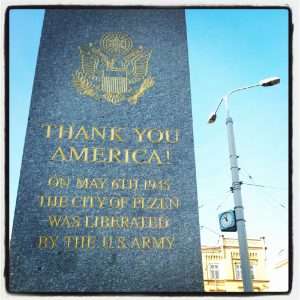 Founded in 1295 by King Wenceslas II, the west Bohemian town of Pilsen was located on a trade route from the German borders to Prague. During the 15th century Hussite wars, Pilsen sided with the Catholics, as most of its inhabitants were Catholic. The city was never conquered during this harsh period in Czech history. In the mid-16th century, Pilsen flourished, ranking third among the biggest cities in Bohemia. At the end of the 16th century, Emperor Rudolf II took refuge in Pilsen when the plague epidemic hit Prague. During the 17th century the Thirty Years’ War, Pilsen supported the Catholics, so they were not punished as a consequence of the religious conflict. Yet in the 1600s and 1700s fires and the plague ravished the town.
Founded in 1295 by King Wenceslas II, the west Bohemian town of Pilsen was located on a trade route from the German borders to Prague. During the 15th century Hussite wars, Pilsen sided with the Catholics, as most of its inhabitants were Catholic. The city was never conquered during this harsh period in Czech history. In the mid-16th century, Pilsen flourished, ranking third among the biggest cities in Bohemia. At the end of the 16th century, Emperor Rudolf II took refuge in Pilsen when the plague epidemic hit Prague. During the 17th century the Thirty Years’ War, Pilsen supported the Catholics, so they were not punished as a consequence of the religious conflict. Yet in the 1600s and 1700s fires and the plague ravished the town.
The 19th century saw major positive developments in the city – Skoda Works was established by Emil Skoda and became the leading arms producer in the Austro-Hungarian Empire. Later the company became a leading engineering enterprise. Now Skoda is famous for the cars it manufactures, to give one example. The brewery in Pilsen started production in October of 1842, and Pilsner Urquell and the pilsner type of beer would capture worldwide attention.
While the Communist period was fraught with oppression, the 1989 Velvet Revolution brought about new opportunities. The town even won the European Capital of Culture 2015 title. With a population of more than 170,000 inhabitants, Pilsen ranks fourth among the biggest cities in the country.
Pilsen and beer
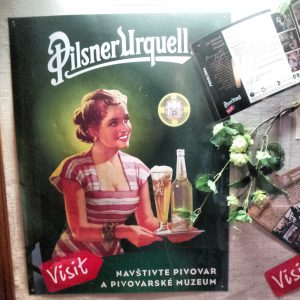 Pilsen’s history is closely associated with beer. When the city was founded in 1295, King Wenceslas II gave burghers his permission to brew beer, and they were able to sell beer in their homes. Town magistrates checked the quality of beer by pouring a pitcher of beer on oak benches. Then they would sit down. They stood up one hour later. If their leather pants did not stick to the bench, the beer was considered undrinkable. In 1838, 36 barrels of bad beer were spilled out in front of the town hall, an event that triggered beermakers to set up a brewery.
Pilsen’s history is closely associated with beer. When the city was founded in 1295, King Wenceslas II gave burghers his permission to brew beer, and they were able to sell beer in their homes. Town magistrates checked the quality of beer by pouring a pitcher of beer on oak benches. Then they would sit down. They stood up one hour later. If their leather pants did not stick to the bench, the beer was considered undrinkable. In 1838, 36 barrels of bad beer were spilled out in front of the town hall, an event that triggered beermakers to set up a brewery.
The history of beer changed when Bavarian brewer Josef Groll came to Pilsen in the 19th century. Incorporating local ingredients and utilizing a new method allowed him to develop a unique kind of beer – the pilsner type, which is now world-renowned. No less than 70 percent of the beer in the world is of the pilsner type.
The brewery
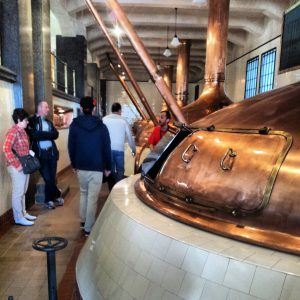 Two of the Czech Republic’s most famous brands of beer, Pilsner Urquell and Gambrinus, are made at the vast brewery near the center of town, a building that was constructed on a former executioners’ site. Tours of the brewery give visitors insight into the beer-brewing process, including the granulation of the Saaz hops and the filtration process. Beer enthusiasts see how the battle lines at the packaging hall work. They also visit the old brewhouse and the new brewhouses. Visitors also tour the cellars, seeing the fermentation and storage areas as well as an ice room. In the cellars it is possible to taste unfiltered, unpasteurized Pilsner Urquell tapped from an oak lager barrel.
Two of the Czech Republic’s most famous brands of beer, Pilsner Urquell and Gambrinus, are made at the vast brewery near the center of town, a building that was constructed on a former executioners’ site. Tours of the brewery give visitors insight into the beer-brewing process, including the granulation of the Saaz hops and the filtration process. Beer enthusiasts see how the battle lines at the packaging hall work. They also visit the old brewhouse and the new brewhouses. Visitors also tour the cellars, seeing the fermentation and storage areas as well as an ice room. In the cellars it is possible to taste unfiltered, unpasteurized Pilsner Urquell tapped from an oak lager barrel.
Other sights at the brewery and practical information
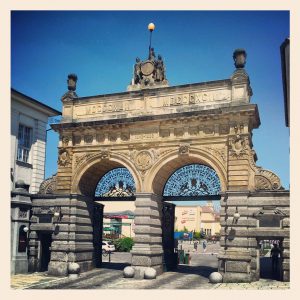 On the premises of the brewery is a decorated Neo-Renaissance portal from 1892 and a water tower erected in 1907. The Gambrinus Brewery dates from 1869, and tours began here in 2010. Check-in advance to see if this brewery is offering tours. Book your ticket in advance at the Pilsner brewery. Lines can be long, and tours in English are only given at certain times of the day. Microbreweries and pubs also are numerous in the city.
On the premises of the brewery is a decorated Neo-Renaissance portal from 1892 and a water tower erected in 1907. The Gambrinus Brewery dates from 1869, and tours began here in 2010. Check-in advance to see if this brewery is offering tours. Book your ticket in advance at the Pilsner brewery. Lines can be long, and tours in English are only given at certain times of the day. Microbreweries and pubs also are numerous in the city.
Republic Square
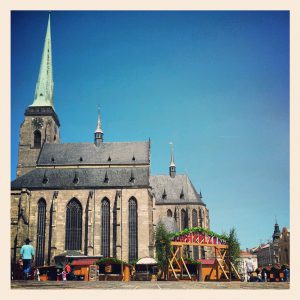 Perhaps it is best to start your tour of Pilsen at Republic Square, one of the largest squares in Europe, measuring 139 meters by 139 meters. Gothic houses once lined the square, and it still has a Gothic and Renaissance flavor. On the northern side of the square stands the Cathedral of Saint Bartholomew, boasting the tallest church tower in the country at a height of 102.6 meters. The cathedral dates back to the founding of the city. The net vault ceiling is 25 meters high. A 134-centimeter tall statue of the Virgin Mary and the Christ Child adorns the Neo-Gothic main altar. Dubbed the Madonna of Pilsen, the statue is considered to be a European masterpiece.
Perhaps it is best to start your tour of Pilsen at Republic Square, one of the largest squares in Europe, measuring 139 meters by 139 meters. Gothic houses once lined the square, and it still has a Gothic and Renaissance flavor. On the northern side of the square stands the Cathedral of Saint Bartholomew, boasting the tallest church tower in the country at a height of 102.6 meters. The cathedral dates back to the founding of the city. The net vault ceiling is 25 meters high. A 134-centimeter tall statue of the Virgin Mary and the Christ Child adorns the Neo-Gothic main altar. Dubbed the Madonna of Pilsen, the statue is considered to be a European masterpiece.
The Renaissance Town Hall and other sights on Republic Square
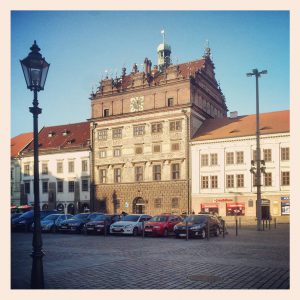 The Renaissance Town Hall with its bewitching sgraffito is also located on the square. It dates back to 1558. Several other buildings nearby are decorated with sgraffito based on drawings by Czech master Mikulas Ales. The Plague Column was built in 1681 and is crowned by a Baroque copy of the Madonna of Pilsen. Other architecturally breathtaking buildings can also be found at Republic Square.
The Renaissance Town Hall with its bewitching sgraffito is also located on the square. It dates back to 1558. Several other buildings nearby are decorated with sgraffito based on drawings by Czech master Mikulas Ales. The Plague Column was built in 1681 and is crowned by a Baroque copy of the Madonna of Pilsen. Other architecturally breathtaking buildings can also be found at Republic Square.
The Great Synagogue
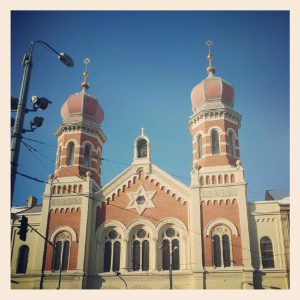 Built in 1892, the Great Synagogue is the largest synagogue in the Czech Republic, the second largest in Europe, and the third-largest in the world with a capacity of over 2,500 worshippers. Viennese architect Max Fleischer designed the original plan for the synagogue, allowing for two 65-meter high towers and buttresses in Gothic style, but his design was not carried out. Pilsen residents did not want the synagogue to be more captivating than the Cathedral of Saint Bartholomew on the main square.
Built in 1892, the Great Synagogue is the largest synagogue in the Czech Republic, the second largest in Europe, and the third-largest in the world with a capacity of over 2,500 worshippers. Viennese architect Max Fleischer designed the original plan for the synagogue, allowing for two 65-meter high towers and buttresses in Gothic style, but his design was not carried out. Pilsen residents did not want the synagogue to be more captivating than the Cathedral of Saint Bartholomew on the main square.
The plans of Emmanuel Klotz, though, were put into effect, and the synagogue opened its doors to the town’s 2,000 Jews in 1893. The towers were made less imposing by lowering them by 20 meters, though the ground plan was the same. The style of the synagogue is eclectic, described as Moorish-Romanesque Revival. A large Star of David dominates the façade. The synagogue even sports a Russian Orthodox look with its onion domes. The ceiling has an Arabic flavor. There are three exquisite stained glass windows and a vestibule that features partially gilded rich stucco adornment. Fortunately, the synagogue was not destroyed during World War II because the Nazis used it as a warehouse.
Museums
The Neo-Renaissance Museum of West Bohemia includes an extensive armory, a Meissen porcelain collection, and exhibitions devoted to archeology and the history of Pilsen from the Middle Ages to the 19th century. The Brewery Museum offers detailed information about the history of beer as part of the identity of the city. The building itself is a sort of museum as it is a 15th-century brewhouse with a Gothic malthouse and two-story cellars. It is also possible to tour the underground areas of Pilsen on an 800-meter tour. The underground passageways were places where food was stored but also served as a way to escape if enemies were trying to conquer the town. The Patton Memorial Museum pays homage to the US Army that freed the town on May 6, 1945.
The Great Theatre
Pilsen boasts the second-longest theatre tradition in the country after Prague. Performances in the town hail from the late 18th century. This impressive theatre was built in Neo-Renaissance style with Art Nouveau features in 1902.
Portals and restaurants
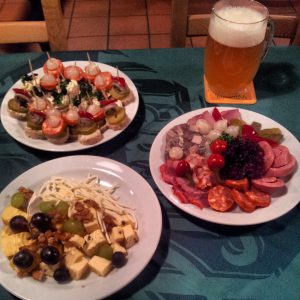 Pilsen is also known for its portals in burghers’ houses. Check out the portal at restaurant and hotel U Salzmannu, a pub-style restaurant offering delicious meals. This former beer hall has a beer-related history. In 1842 the original owner, the unpleasant coachman Martin Salzmann, sent some Pilsner Urquell beer to his friend, a tailor in Prague named Jakub Pinkas. The tailor Pinkas was so impressed that he opened his own pub, U Pinkasu, in Prague. It is still one of the most popular pubs in the capital city.
Pilsen is also known for its portals in burghers’ houses. Check out the portal at restaurant and hotel U Salzmannu, a pub-style restaurant offering delicious meals. This former beer hall has a beer-related history. In 1842 the original owner, the unpleasant coachman Martin Salzmann, sent some Pilsner Urquell beer to his friend, a tailor in Prague named Jakub Pinkas. The tailor Pinkas was so impressed that he opened his own pub, U Pinkasu, in Prague. It is still one of the most popular pubs in the capital city.
Gardens and more
There are also many beautiful gardens in the center of the town. The Krizik Gardens are home to the Theatrum Mundi, the largest mural in the country. Completed in 2001, the mural depicts personalities from the town’s history, such as Emperor Rudolf II, the composer of the Czech national anthem Josef Kajetan Tyl, and engineering entrepreneur Emil Skoda.
A few other sights
The Municipal Meeting House is a Neo-Renaissance building with lavish Art Nouveau décor. Two social halls, restaurants, and an Art Nouveau café call this building home. A zoo is also located in the city.
A city for everyone
Pilsen’s rich history comes alive as visitors stroll through the historical center of town where burghers’ houses are plentiful. Gardens dot the center as do museums. The Cathedral of Saint Bartholomew dominates the downtown area while the Great Synagogue amazes with its size and rich exterior and interior decoration. Most of all, beer plays a prominent role in the town’s history. Be sure to take a tour of the brewery and to visit the Beer Museum for a close look at how this alcoholic beverage has shaped the city’s character throughout the centuries.




